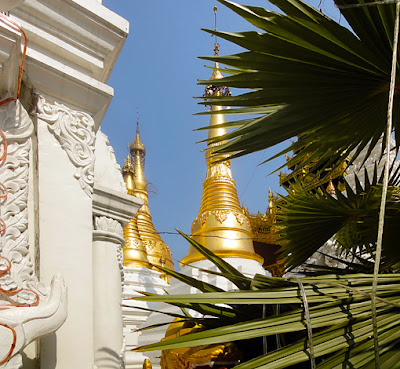Sacred monuments in Buddhism.
Although they all somehow look the same the shape is marginally different, they are also built in various sizes and materials. Most common are bricks and stones, the are covered with plaster and painted in white.
Sometime if the builder has some extra money they cover them even with gold plates, some good example are the Shwedagon Stupa in Yangon and the Shwezigon in Bagan for genuine Burmese Days.
Buddhist devotees have placed relics in a small chamber inside the stupa, of remembrance and for the construction of the stupa sacrificed precious objects. As such a basic type of stupa is a characteristic a religious building, with some specific differences in forms and materials used to various countries. Over the centuries it has undergone a complicated symbolic interpretation that is related to the cosmological ideas of peoples.
The pagoda structure is regarded as an image of the universe, its creative powers, a tree or fountainhead of life, as the embodiment of various mental states which express the development and the state of mind of the people, and sometimes even as a symbolic iconic representation of Buddha.
In all this, the characteristic of the thinking of medieval man believes reflects; after the symbolic architectural form expresses the cosmic order. The great stupas were the focus of architectural ensembles that also included works of fine art. The stupa or Buddha sculptures were subjects of the veneration which numerous reliefs, however, the walls and gates are much decorated and never regarded as an object of worship.
This vividly shows the life of Gautama Buddha, from his previous incarnations of his virtues and his intellectual and moral victories. They represented a kind of introduction to Buddhism, which served the match, the construction and preparation of the uninitiated. This feature of the works of fine art certainly also has something to do with the interpretation of the religious symbolic.
In the early Buddhist art and on the reliefs of stone fences, which (1st to 3rd century) and Amaravati (1st-2nd century) surrounded the Indian stupas in Bharhut (2nd century), Sanchi, symbolized the image of the Stupa one of the four major events in the life of Gautama Buddha, namely the Parinirvana, the "way to the Nirvana", was received immediately after his death.
Therefore, the image of the stupas was often a symbol of the Buddha's death. The up to now preserved stupas of Thayekhetaya, Payagyi, Bawbawgyi and Payama were built in the 6th to the 9th century and rise beyond the city walls in close proximity to the city. They have a step-like circular base (Burmese: Pisseyan) on which the structur rested, the so-called Kaunglaung, which means bell.
The Payagyi and Payama Stupa crowned by a Hti (umbrella). The Pisseyan, Kaunglaung and Hti are also the three major parts of the stupas of later times, as they were built throughout the historical evolution of the Burmese architecture to the present day. In most cases they are stupas of larger dimensions that can reach up to 40 meters or more in height.
The stupas of Thayekhetaya arouse particular attention due to their shape. This differs significantly from the Indian and Sinhalese prototypes that were built prior to and at the beginning of our count. The famous stupas of Sanchi, the other of the caves of Karla and Ajanta (India) and of Anuradhapura (Sri Lanka) with its hemispherical, slightly stocky figure similar to the long-drawn upwards stupas of Thayekhetaya which according to current knowledge in the neighboring countries have no analogies in any way.
- Buddha statues in different postures but usually sitting.
- Buddhist novice is a state almost every boy is going through in this environment.
- Buddhist religion here is some more about but rather basic.
- Buddhist shrine come in many forms, some are lavish decorated.




No comments:
Post a Comment